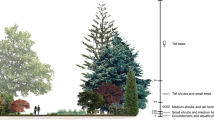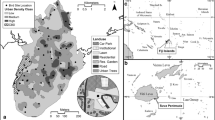Abstract
The increasing acknowledgement of the importance of urban habitats in the maintenance of biodiversity has brought with it a need to quantify this importance at a scale appropriate to the characteristic patch sizes encountered in urban areas. Taking a study area in the Black Country (UK) we used a spatially complete, rapid assessment method to evaluate habitat patches in terms of their internal structural heterogeneity. This method recognises the importance of both natural and anthropogenic processes in providing a diverse range of habitats and niches for both flora and fauna. It also recognises the key role of context in determining the ecological significance of each patch within the urban landscape.
All habitats studied had a complex mix of both natural and artificial structural elements, where an element is a within-patch contributor to structural diversity, with each habitat type having a large range of element totals. Characteristic totals, reflecting the level of habitat structural diversity, were observed in some habitat types with residential areas having high values and industrial and commercial areas having low values. Certain structural elements were also associated with each habitat type allowing characteristic element assemblages to be derived. If structural diversity is linked with biodiversity, as seems to be the case in many (though not all) habitat types, then this unique method of viewing the urban landscape becomes a powerful tool for informing wildlife ecologists, nature conservationists, urban planners, environmental managers and landscape architects.
Similar content being viewed by others
References
Agger, P. and Brandt, J. (1988) Dynamics of small biotopes in Danish agricultural landscapes. Landscape Ecology 1(4), 227-240.
Alpert, P. (1991) Microtopography as habitat structure for mosses on rocks. In Habitat Structure: The Physical Arrangement of Objects in Space (S.S. Bell, E.D. McCoy and H.R. Mushinsky, eds.), pp. 120-140. Chapman and Hall, London.
Barker, G.M.A. (1997) A framework for the future: green networks with multiple uses in and around towns and cities. English Nature Research Report, no. 256, English Nature, Peterborough.
Bichlmeier, F., Brunner, M., Patsch, J., Mück, H. and Wenisch, E. (1980) Biotope mapping in the city of Augsberg. Garten und Landschaft 7/80, pp. 551-559.
Brown, V.K. (1991) The effects of changes in habitat structure during succession in terrestrial communities. In Habitat Structure: The Physical Arrangement of Objects in Space (S.S. Bell, E.D. McCoy and H.R. Mushinsky, eds.), pp. 141-168. Chapman and Hall, London.
Carr, S. and Lane, A. (1993) Practical Conservation—Urban Habitats. Hodder and Stoughton, London.
Cueto, V.R. and de Casenave, J.L. (1999) Determinants of species richness: role of climate and vegetation structure at a regional scale. Journal of Biogeogaphy 26, 487-492.
Dickman, C.R. (1987) Habitat fragmentation and vertebrate species richness in an urban environment. Journal of Applied Ecology 24, 337-351.
Flather, C.H., Brady, S.J. and Inkley, D.B. (1992) Regional habitat appraisals of wildlife communities: a landscape-level evaluation of a resource planning model using avian distribution data. Landscape Ecology 7(2), 137-147.
Gilbert, O.L. (1989) The Ecology of Urban Habitats. Chapman & Hall, London.
Hardy, P.B. and Dennis, R.L.H. (1999) The impact of urban development on butterflies within a city region. Biodiversity and Conservation 8, 1261-1279.
Jarvis, P. (1996) Planning for a green environment in Birmingham. In Managing a Conurbation: Birmingham and it's Region (A.J. Gerrard and T.R. Slater, eds.), pp. 90-100. Brewin Books, Studely.
Kent, M., Stevens, R.A. and Zhang, L. (1999) Urban plant ecology patterns and processes: a case study of the flora of the City of Plymouth, Devon, U.K. Journal of Biogeography 26, 1281-1298.
Kirby, P. (1992) Habitat Management for Invertebrates: A Practical Handbook. RSPB, Sandy.
Kleyer, M. (1994) Habitat network schemes in Stuttgart. In Landscape Planning and Ecological Networks (E.A. Cook and H.N van Lier, eds.), pp. 249-272. Elsevier, Amsterdam.
Kotzageorgis, G.C. and Mason, C.F. (1997) Small mammal populations in relation to hedgerow structure in an arable landscape. Journal of Zoology 242, 425-434.
Kunick, W. (1980) Plants to which special attention should be paid when mapping urban areas. Garten und Landschaft 7/80, 577-580.
LaGro Jr., J.A. and DeGloria, S.D. (1992) Land use dynamics within an urbanizing non-metropolitan county in New York State (USA). Landscape Ecology 7(4), 275-289.
Lancaster, R.K. and Rees, W.E. (1979) Bird communities and the structure of urban habitats. Canadian Journal of Zoology 57, 2358-2368.
McDonnell, M.J. (1997) A paradigm shift. Urban Ecosystems 1(2), 85-86.
McDonnell, M.J. and Pickett, S.T.A. (1990) Ecosystem structure and function along rural-urban gradients: an unexploited opportunity for ecology. Ecology 71(4), 1232-1237.
McDonnell, M.J., Pickett, S.T.A., Groffman, P., Bohlen, P., Pouyat, R.V., Zipperer, W.C., Parmelee, R.W., Carreiro, M.M. and Medley, K. (1997) Ecosystem processes along an urban-to-rural gradient. Urban Ecosystems 1(1), 21-36.
Maurer, U., Peschel, T. and Schmitz, S. (2000) The flora of selected urban land-use types in Berlin and Potsdam with regard to nature conservation in cities. Landscape and Urban Planning 46, 209-215.
Nature Conservancy Council (1990) Handbook for Phase-1 Habitat Survey—A Technique for Environmental Audit. N.C.C., Peterborough.
Owen, J. (1991) The Ecology of a Garden: The First Fifteen Years. Cambridge University Press, Cambridge.
Plachter, H. (1980) Animal populations in built up areas, and their inclusion within the context of biotope mapping. Garten und Landschaft 7/80, 569-576.
Pomarol, M. (1996) Artificial nest structure design and management implications for the lesser kestrel Falco naumanni. Journal of Raptor Research 30(3), 169-172.
Pyšek, P. (1998) Alien and native species in Central European urban floras: a quantitative comparison. Journal of Biogeography 25, 155-163.
Ratcliffe, D.A. (1977) A Nature Conservation Review. University Press, Cambridge.
Raven, S.J. and Coulson, J.C. (1997) The distribution and abundance of Larus gulls nesting on buildings in Britain and Ireland. Bird Study 44(1), 13-34.
Schippers, P., Verboom, J.P., Knaapen, J.P. and van Apeldoorn, R.C. (1996) Dispersal and habitat connectivity in complex heterogeneous landscapes: an analysis with a GIS-based random walk model. Ecography 19, 97-106.
Stott, P. (1998) Biogeography and ecology in crisis: the urgent need for a new metalanguage. Journal of Biogeography 25, 1-2.
Sukopp, H. and Weiler, S. (1988) Biotope mapping and nature conservation strategies in urban areas of the Federal Republic of Germany. Landscape and Urban Planning 15, 39-58.
Tonteri, T. and Haila, Y. (1990) Plants in a Boreal city: ecological characteristics of vegetation in Helsinki and it's surroundings, southern Finland. Annales Botanici Fennici 27, 337-352.
Uetz, G.W. (1991) Habitat structure and spider foraging. In Habitat Structure: The Physical Arrangement of Objects in Space (S.S. Bell, E.D. McCoy and H.R. Mushinsky, eds.), pp. 325-348. Chapman and Hall, London.
Villa, F., Ceroni, M. and Mazza, A. (1996) A GIS-based method for multi-objective evaluation of park vegetation. Landscape and Urban Planning 35, 203-212.
Walker, D.A. and Walker, M.D. (1991) History and pattern of disturbance in Alaskan Arctic terrestrial ecosystems: a hierarchical approach to analysing landscape change. Journal of Applied Ecology 28, 244-276.
Wittig, R. and Schreiber, K.-F. (1983) A quick method for assessing the importance of open spaces in towns for urban nature conservation. Biological Conservation 26, 57-64.
Wood, P.A. and Samways, M.J. (1991) Landscape element pattern and continuity of butterfly flight paths in an ecologically landscaped botanic garden, Natal, South Africa. Biological Conservation 58, 149-166.
Young, C.H. and Jarvis, P.J. (2001) A simple method for predicting the consequences of land-management in urban habitats. Environmental Management 28(3), 375-387.
Author information
Authors and Affiliations
Rights and permissions
About this article
Cite this article
Young, C.H., Jarvis, P.J. Assessing the structural heterogeneity of urban areas: an example from the Black Country (UK). Urban Ecosystems 5, 49–69 (2001). https://doi.org/10.1023/A:1021877618584
Issue Date:
DOI: https://doi.org/10.1023/A:1021877618584




